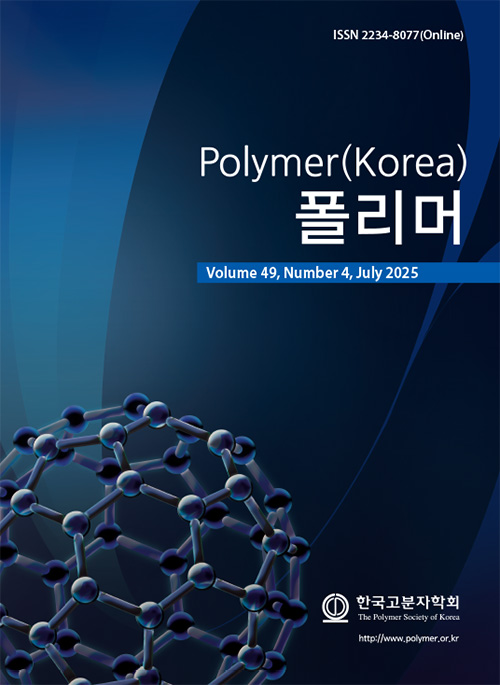- Development of Measurement Technology for Uptake and Diffusivity of Hydrogen Gas in Peroxide-Crosslinked EPDM Polymer Composites Blended with Fillers using Image Analysis Algorithm of Cylinder Water Level
Ji Hun Lee*, **,†
 , Sang Koo Jeon**, Myung Chan Choi***, and Seung Yeon Kim****
, Sang Koo Jeon**, Myung Chan Choi***, and Seung Yeon Kim*****Department of Measurement Science, University of Science and Technology, Deajeon 34113, Korea
**Hydrogen Energy Materials Research Center, Korea Research Institute of Standards and Science, Daejeon 34113, Korea
***Korea Institute of Materials Convergence Technology, 152, Danggamseo-ro, Busanjin-gu, Busan 47154, Korea
****Department of Electronic Engineering, Kyung Hee University, 1732 Deogyeong-daero, Giheung-gu, Yongin, Gyeonggi-do 17104, Korea- 실린더 수위의 이미지 분석 알고리즘을 이용한 충전제가 함유된 페록사이드 가교 EPDM 고분자 복합체의 수소 기체 충전량 및 확산도 측정 기술 개발
*과학기술연합대학원대학교 한국표준과학연구원 측정과학전공, **한국표준과학연구원 수소에너지소재연구팀, ***한국소재융합연구원 탄성소재연구단, ****경희대학교 전자공학과
Reproduction, stored in a retrieval system, or transmitted in any form of any part of this publication is permitted only by written permission from the Polymer Society of Korea.
Polymer O-rings are used for gas sealing in high-pressure hydrogen vessels and transfer pipes at hydrogen refueling stations. In this study, a technique was developed to measure the hydrogen uptake and diffusivity of these polymer O-ring materials. After hydrogen is charged into the polymer material under high-pressure hydrogen environments up to 90 MPa, the pressure is reduced, and the material is placed into the empty space of a cylinder partially submerged in water. Due to the pressure difference, the hydrogen inside the polymer material is released. The released hydrogen causes a decrease in the water level inside the cylinder, corresponding to an increase in the hydrogen gas volume. To measure these volume changes in real-time, an algorithm that analyzes the brightness of the crescent-shaped water level image inside the cylinder was developed, allowing for precise real-time tracking of the water level. Using the volume change data, the amount of released hydrogen gas in moles is calculated by applying the ideal gas law. By applying this data to a self-developed diffusivity analysis program, the hydrogen uptake and diffusivity of the polymer material can be quantitatively evaluated. This technology was applied to evaluate hydrogen uptake and diffusivity in peroxide-crosslinked ethylene propylene diene monomer (EPDM) composites containing carbon black and silica fillers. The relationship between filler types and the hydrogen uptake/diffusivity of EPDM composites, was measured across a pressure range of 2 MPa to 90 MPa. The effects of fillers and pressure on hydrogen uptake and diffusivity were studied. Additionally, the correlation between the physical stability of EPDM composites and their hydrogen uptake/diffusivity was investigated. A positive proportional relationship was found between the volume expansion of the EPDM composite and the hydrogen uptake/diffusivity, while a negative proportional relationship was observed between the polymer's density and its hydrogen uptake/diffusivity.
수소 충전소의 고압 수소 용기와 이송용 배관의 가스 씰에는 고분자 오링이 사용된다. 본 연구에서는 이러한 고분자 오링 소재의 수소 충전량과 확산도를 측정할 수 있는 기술을 개발하였다. 최대 90 MPa의 고압 수소 환경에서 고분자 소재에 수소를 충전한 후 감압하고, 이를 물이 부분적으로 잠긴 실린더의 빈 공간에 넣으면 압력 차에 의해 고분자 소재 내부의 수소가 방출된다. 방출된 수소는 실린더 내부의 수위를 감소시키며, 이는 수소 가스 부피의 증가에 해당한다. 이러한 부피 변화를 실시간으로 측정하기 위해, 실린더 내부 초승달 형태의 수위 이미지를 밝기 분석하는 알고리즘을 개발하여 수위를 정밀하게 실시간 추적할 수 있다. 수위 변화, 즉 부피 변화 데이터를 기반으로 이상기체 상태 방정식을 적용하여 방출된 수소 기체의 몰 수를 계산한다. 이를 자체 개발한 확산도 분석 프로그램에 적용함으로써 고분자 소재의 수소 충전량과 확산도를 정량적으로 평가할 수 있다. 이러한 기술을 이용하여 고분자 소재의 물성 향상을 위한 카본블랙과 실리카 충전제가 함유된 페록사이드 가교된 ethylene propylene diene monomer(EPDM) 복합체 고분자 소재의 충전제의 종류 및 중량비 변화에 대한 EPDM 소재의 수소 충전량 및 확산도를 2-90 MPa 까지 측정하였다. 충전제와 압력의 영향에 대한 수소 충전량과 확산도 관계를 연구하였다. 또한 EPDM 고분자 복합체의 물리적 안정성과 수소 충전량 및 확산도의 상관성을 조사하였다. EPDM 복합체의 부피팽창과 수소 충전량과 확산도 사이에 양의 비례적인 관계가 발견되었고, 반면 고분자 소재의 밀도와 수소 충전량과 확산도는 음의 비례관계를 얻었다.
Keywords: image analysis algorithm, polymer, hydrogen uptake, hydrogen diffusion, uncertainty, volumetric measurement.
- Polymer(Korea) 폴리머
- Frequency : Bimonthly(odd)
ISSN 2234-8077(Online)
Abbr. Polym. Korea - 2024 Impact Factor : 0.6
- Indexed in SCIE
 This Article
This Article
-
2025; 49(4): 499-511
Published online Jul 25, 2025
- 10.7317/pk.2025.49.4.499
- Received on Feb 3, 2025
- Revised on Mar 19, 2025
- Accepted on Mar 20, 2025
 Correspondence to
Correspondence to
- Ji Hun Lee
-
*Department of Measurement Science, University of Science and Technology, Deajeon 34113, Korea
**Hydrogen Energy Materials Research Center, Korea Research Institute of Standards and Science, Daejeon 34113, Korea - E-mail: ljh93@kriss.re.kr








 Copyright(c) The Polymer Society of Korea. All right reserved.
Copyright(c) The Polymer Society of Korea. All right reserved.